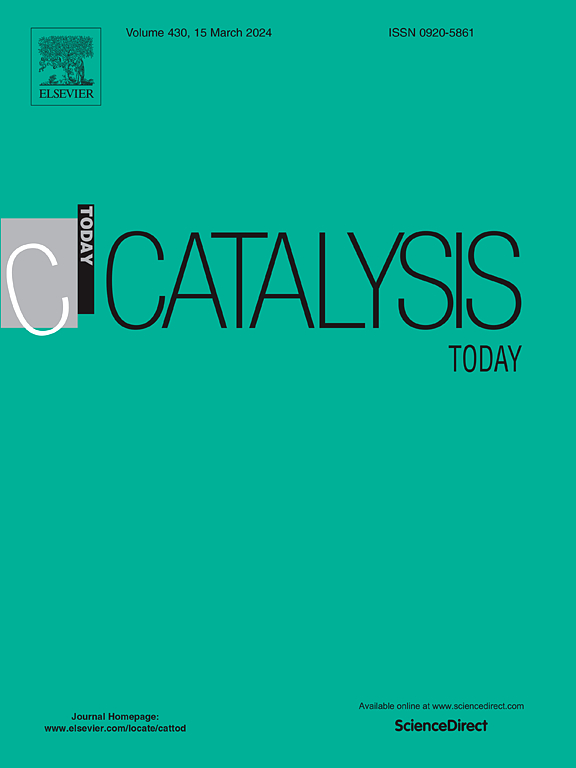以γ-戊内酯为原料的生物基尼龙中间体:改进催化剂以提高对 4-戊烯酸甲酯的选择性
IF 5.2
2区 化学
Q1 CHEMISTRY, APPLIED
引用次数: 0
摘要
在气相连续工艺中,使用改性含锆催化剂对生物基γ-戊内酯(GVL)进行开环酯交换反应,生成了戊烯酸甲酯异构体(MP)混合物,如 4-戊烯酸甲酯(M4P)、3-戊烯酸甲酯(M3P)和 2-戊烯酸甲酯(M2P)。由于这三种 MP 异构体是潜在的尼龙中间体,因此从绿色化学的角度来看,这种方法在合成生物基聚合物方面具有可持续性。反应在固定床催化反应器中进行,环境压力和温度范围为 255 至 335°C。在本研究中,通过湿法浸渍制备了二氧化硅支撑的氧化锆催化剂,Zr 的负载量在 5 到 30 wt% 之间。催化剂采用多种技术进行表征。通过 N2 吸附测定了表面积,通过 NH3-TPD 和 CO2-TPD 技术测定了酸碱性质。此外,还通过 Py-FTIR 对路易斯位点和布氏位点的区别进行了估计。在所有催化剂中,25% Zr/SiO2 的性能最佳。研究人员探讨了各种关键反应参数对活性/选择性的影响,并优化了合适的反应条件。研究发现,GVL 的转化率和产物分布与催化剂的反应温度和 Zr 含量密切相关。所有三种 MP 异构体的总选择性在 97 % 到 99 % 之间变化,其中 M4P 始终是主要产物。在低反应温度(255°C)下,M4P 是主要产物,而 M2P 则是次要产物。然而,随着温度的升高,由于 CC 双键的异构化,M2P 和 M3P 的选择性增加,而 M4P 的选择性降低。此外,还探讨了支持物对最佳 Zr 负载的影响,结果发现 SiO2 支持物的性能优于其他支持物。为了提高 M4P 的选择性,还在本研究的最佳催化剂 25Zr/SiO2 中掺入了铬。铬的掺入大大提高了 M4P 的选择性,在 GVL 可接受的高转化率条件下,其选择性超过 80%。本文章由计算机程序翻译,如有差异,请以英文原文为准。
Bio-based nylon intermediates from γ-valerolactone: Catalyst modifications for an enhanced selectivity to methyl 4-pentenoate
Ring-opening transesterification of bio-based γ-valerolactone (GVL) to produce a mixture of methyl pentenoate isomers (MPs) such as methyl 4-pentenoate (M4P), methyl 3-pentenoate (M3P) and methyl 2-pentenoate (M2P) has been carried out using modified Zr-containing catalysts in a gas phase continuous process. As the three MP isomers are potential nylon intermediates, this approach is sustainable from a green chemistry point of view to synthesize bio-based polymers. The reaction was carried out in a fixed bed catalytic reactor at ambient pressure and in the temperature range from 255 to 335°C. In the present study, SiO2 supported zirconia catalysts were prepared by wet impregnation with varying Zr loadings in the range from 5 to 30 wt%. The catalysts were characterized by various techniques. The surface areas were determined by N2 adsorption, acid-base properties by NH3-TPD and CO2-TPD techniques. In addition, the distinction of Lewis and Brønsted sites were also estimated by Py-FTIR. Among all catalysts, 25 % Zr/SiO2 exhibited the best performance. The influence of various key reaction parameters on the activity/selectivity was explored and suitable reaction conditions were optimized. The conversion of GVL and product distribution was found to be strongly dependent on the reaction temperature and Zr content of the catalysts. The sum selectivity of all the three MP isomers varied in the range from 97 % to 99 %, of which M4P was always the dominant product. At low reaction temperature (255°C), M4P was the major product while M2P was a minor product. However, with increase in temperature, the selectivity of M2P and M3P increased at the expense of M4P due to isomerisation of the C![]() C double bond. In addition, the effect of support on the best Zr loading was also explored and it was found that the SiO2 support exhibited superior performance compared to others. In the direction of enhancing the selectivity of M4P, Cr-doping was also done onto 25Zr/SiO2, the best catalyst of this study. Such incorporation of chromium significantly enhanced the selectivity of M4P above 80 % at acceptably high conversion of GVL.
C double bond. In addition, the effect of support on the best Zr loading was also explored and it was found that the SiO2 support exhibited superior performance compared to others. In the direction of enhancing the selectivity of M4P, Cr-doping was also done onto 25Zr/SiO2, the best catalyst of this study. Such incorporation of chromium significantly enhanced the selectivity of M4P above 80 % at acceptably high conversion of GVL.
求助全文
通过发布文献求助,成功后即可免费获取论文全文。
去求助
来源期刊

Catalysis Today
化学-工程:化工
CiteScore
11.50
自引率
3.80%
发文量
573
审稿时长
2.9 months
期刊介绍:
Catalysis Today focuses on the rapid publication of original invited papers devoted to currently important topics in catalysis and related subjects. The journal only publishes special issues (Proposing a Catalysis Today Special Issue), each of which is supervised by Guest Editors who recruit individual papers and oversee the peer review process. Catalysis Today offers researchers in the field of catalysis in-depth overviews of topical issues.
Both fundamental and applied aspects of catalysis are covered. Subjects such as catalysis of immobilized organometallic and biocatalytic systems are welcome. Subjects related to catalysis such as experimental techniques, adsorption, process technology, synthesis, in situ characterization, computational, theoretical modeling, imaging and others are included if there is a clear relationship to catalysis.
 求助内容:
求助内容: 应助结果提醒方式:
应助结果提醒方式:


